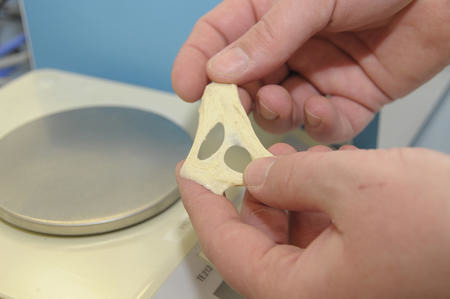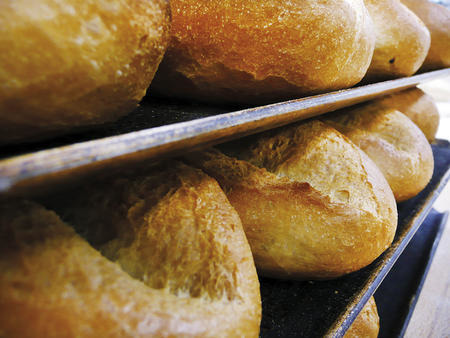International
Urgently required: Rapid determination of baking characteristics
How will and must wheat quality change in the future? Is buying according to crude protein content and fall rates still up to date? These and other topics were the subject of discussion of the VDM Committee for Raw Materials and Markets, which met in September at SAATEN-UNION in Isernhagen.
Committee chairman Stephan Kill (Roland Mills West GmbH) stressed already during the introductory speech: "We have already said "Good bye" to only buying and selling according to raw protein (RP) and falling number. It is indispensable that we change this buying behaviour and analyse the value adding chain from start to finish and make it transparent. Our task is to find a common positioning and translate the targets into the raw material procurement". Involving the wheat producers at this point is very welcome: "Right now, we welcome an open discussion".
Dialogue creates trust
Marcus Iken (SAATEN-UNION) stressed that the seven partners of SAATEN-UNION as medium-sized breeders provide wide-spread wheat genetics for all utilisation purposes. Furthermore, it is very important for the company to realise market trends in good time by staying in constant dialogue with associations and research facilities, and to align the breeding activities accordingly. The prompt alignment to the practical situation, the intensive dialogue with the farmers, creates a basis of trust, which is growing more and more in importance in this age of mega-mergers.
Genetic variety is important for a wide offer of varieties
Wheat breeder Dr. Martin Kirchhoff (Nordsaat Saatzucht) also stresses the genetic span of the product range. One breeds for an area ranging "from the Ural mountains down to the Atlantic Ocean" and the genetics must be correspondingly broad. Apart from classical breeding work on over 100,000 plots, modern time-saving and effective biotechnology methods are employed in the development of new varieties. Due to the lack of acceptance on the European markets, the company does not employ genetic engineering procedures - and Kirchhoff also distanced himself from new methods such as CRISPR: "They are unsuitable for the design of transparent breeding work and therefore clash with our company philosophy", he stressed. Patenting agricultural crop plants would also block a market-oriented offer. "Factually speaking, the currently practised exchange of different genetics would thus be blocked and the result would be a reduced genetic variety on the variety market - and this would also mean a reduced breeding progress," sums up Kirchhoff.
Soon only 11.5 % crude protein?
Sven Böse of SAATEN-UNION described the extremely comfortable situation that the mills find themselves in at the moment. Never before has there been such an extensive offer of quality wheat varieties available to the millers than there is today. But he also stressed that following the amendment of the fertilisation ordinance the processing firms will have to adjust in the mid-term to A-baking qualities with only 11-12 % RP. "Due to the capped nitrogen offer, an increased yield is only possible using nitrogen efficient varieties and decreasing RP-contents. This is due to the close relation between protein and yield, where 1 % RP content (abs.) corresponds to a yield difference of approximately 8 dt/ha. 12.5 and 13 % are also possible in the future, but have to be appropriately remunerated", is his demand. Interesting for the future are the "correlation breakers": On the one hand, varieties that realise comparatively high yields with higher raw protein contents, such as the variety NORDKAP (A). On the other hand, varieties that offer high baking yields already at lower raw protein contents, such as FAUSTUS (B).
Markets demand new qualities
All mill representatives confirmed that the manufacturing processes as well as the customer demands have changed. An example of this was regional production. More and more firms ranging from the regional baker to the large retail chains are placing emphasis on offering regionally produced product ranges. But anyone guaranteeing a precise product identity in mass goods like cereal, in other words consistency of the products (unaltered character of the goods), runs a high risk: Due to the weather conditions, regional qualities can vary considerably and thus endanger quality stability of the end products. Normally, cereal batches with a deficiency in one quality are balanced with a different one that is particularly strong there. This is a common and robust procedure, which may be impossible at times – depending on the weather conditions – when only using regionally produced products.
A further example is deep frozen ready-to-bake bread rolls or baking products: These products require completely different baking properties (e.g. dough stability time) to customary bread rolls. The modern food and luxury food sector is filled with special products requiring special flours: Against this background, however, the logical conclusion seems to be to specifically buy-in according to variety types/characters. And exactly at this point, it makes no sense anymore to only use the raw protein content as value determining characteristic.
Quick test for baking quality demanded!
The missing quick test for registration at the mill, however, was always the sticking point in all the ideas and proposals made during the discussion regarding topics such as the common registration of quality varieties with low raw protein contents.
Raw protein content and falling number are mainly used in buying, as they can be determined in quick tests when accepting the grain. More important from the view point of the mills, however, would be a quick test of the baking quality. But the tests available up to now take too long, so that the cereal have to be kept separate until the results of the test are available. A separation of the individual batches in the accepting firm simply cannot be handled and also is too expensive.
| Thus, in his closing words, Kill only sees the possibility for change as soon as there is an available quick test. "As long as it is not possible to quickly test specific baking properties, the qualities required by the customer must still be mixed from the qualities present." It is possible to define variety characteristics for special products and product niches, determine the matching varieties with the help of the breeders and secure these batches using contract growing or targeted buy-in. |
Dr. Anke Boenisch
Status: 19.10.16





